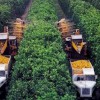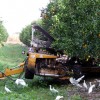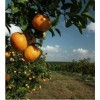 Mechanization has been the hallmark of American agriculture. Nearly 100 percent of the agronomic crops grown in the United States are plowed, planted, and harvested with mechanical equipment. Mechanical harvesting equipment for sweet oranges has been studied extensively since the 1970s and during the 2005/06 harvest season, trunk and canopy shakers harvested more than 36,000 acres of Florida citrus. Mechanically harvested citrus acreage, however, has decreased significantly since 2005. During the 2012/13 season, less than 9,000 acres were mechanically harvested (FDOC 2013). Nevertheless, development and adoption of mechanical harvesting technology is important to the long-term economic sustainability of the Florida orange juice processing industry. This 5-page fact sheet describing canopy shakerswas written by F.M. Roka, R.J. Ehsani, S.H. Futch, and B.R. Hyman, and published by the UF Department of Food and Resource Economics, August 2014.
Mechanization has been the hallmark of American agriculture. Nearly 100 percent of the agronomic crops grown in the United States are plowed, planted, and harvested with mechanical equipment. Mechanical harvesting equipment for sweet oranges has been studied extensively since the 1970s and during the 2005/06 harvest season, trunk and canopy shakers harvested more than 36,000 acres of Florida citrus. Mechanically harvested citrus acreage, however, has decreased significantly since 2005. During the 2012/13 season, less than 9,000 acres were mechanically harvested (FDOC 2013). Nevertheless, development and adoption of mechanical harvesting technology is important to the long-term economic sustainability of the Florida orange juice processing industry. This 5-page fact sheet describing canopy shakerswas written by F.M. Roka, R.J. Ehsani, S.H. Futch, and B.R. Hyman, and published by the UF Department of Food and Resource Economics, August 2014.
http://edis.ifas.ufl.edu/fe951
Tag: Mechanical Harvesting
Citrus Mechanical Harvesting Systems–Trunk Shakers
 While citrus growers are rightfully concerned about restoring the health of their HLB-infected trees, more study and consideration should be given to mechanical harvesting. The costs to grow and harvest citrus have been escalating significantly since 2006, and the cost savings potential from mechanical harvesting technologies can help Florida growers remain economically viable. This 4-page fact sheet was written by F.M. Roka, R.J. Ehsani, S.H. Futch, and B.R. Hyman, and published by the UF Department of Food and Resource Economics, August 2014.
While citrus growers are rightfully concerned about restoring the health of their HLB-infected trees, more study and consideration should be given to mechanical harvesting. The costs to grow and harvest citrus have been escalating significantly since 2006, and the cost savings potential from mechanical harvesting technologies can help Florida growers remain economically viable. This 4-page fact sheet was written by F.M. Roka, R.J. Ehsani, S.H. Futch, and B.R. Hyman, and published by the UF Department of Food and Resource Economics, August 2014.
http://edis.ifas.ufl.edu/fe950
Analyzing Production Records of Commercial Sweet Orange Blocks to Measure Effects of Mechanical Harvesting on Long-Term Production and Tree Health
 Ever since mechanical harvesting systems were introduced in the 1960s, growers expressed serious concerns over the potential negative impact mechanical harvesting could have on their trees. A study was undertaken in 2010 to analyze grower production data and compare whether mechanical harvesting had an adverse effect on fruit yield or shortened tree longevity as compared to hand harvesting. The purpose of this article is to describe how the study was organized and to summarize its results and conclusions. This 4-page fact sheet was written by Fritz M. Roka, Lisa H. House, and Katrina R. Mosley, and published by the UF Department of Food and Resource Economics, May 2014.
Ever since mechanical harvesting systems were introduced in the 1960s, growers expressed serious concerns over the potential negative impact mechanical harvesting could have on their trees. A study was undertaken in 2010 to analyze grower production data and compare whether mechanical harvesting had an adverse effect on fruit yield or shortened tree longevity as compared to hand harvesting. The purpose of this article is to describe how the study was organized and to summarize its results and conclusions. This 4-page fact sheet was written by Fritz M. Roka, Lisa H. House, and Katrina R. Mosley, and published by the UF Department of Food and Resource Economics, May 2014.
http://edis.ifas.ufl.edu/fe949
FE752 Benefits of an Abscission Agent in Mechanical Harvesting of Citrus
FE752, a 4-page fact sheet by Fritz Roka, Jackie Burns, Jim Syvertsen, and Robert Ebel, describes research into the use of abcission agents in mechanical harvesting, to extend the harvesting window to later in the season, permit faster harvesting speed, enhance fruit recovery percentages, and reduce tree damage. Includes references. Published by the UF Department of Food and Resource Economics, September 2008.
http://edis.ifas.ufl.edu/FE752
FE751 A Decision-Aid Tool to Compare Costs of Mechanical Harvesting Systems
FE751, a 4-page illustrated fact sheet by Fritz Roka, provides instructions in the use of a Web-based tool to help growers and harvesting contractors organize relevant harvest cost information and then calculate and compare net harvest costs among all available harvesting options. Published by the UF Department of Food and Resource Economics, September 2008.
http://edis.ifas.ufl.edu/FE751